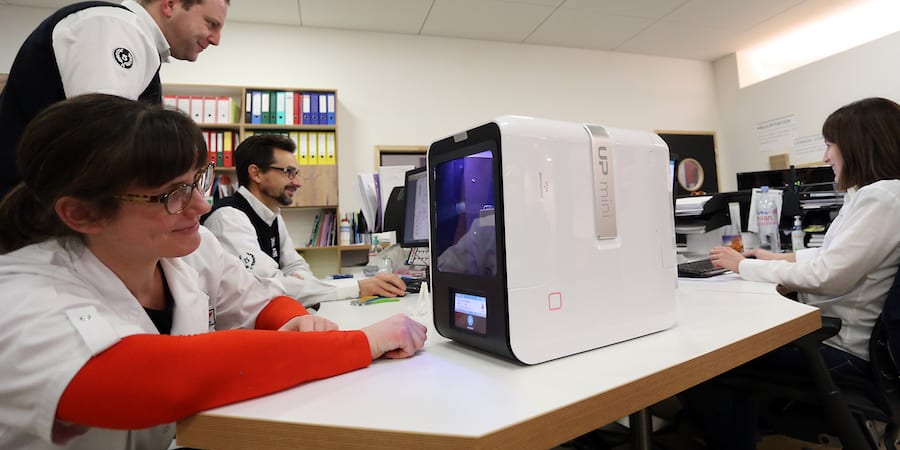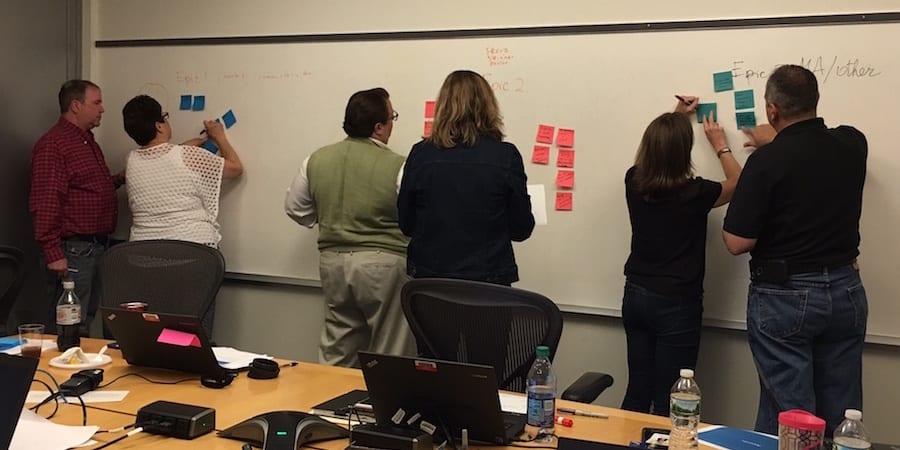
People development and competitivess - the Alliance story
NOTES FROM THE GEMBA – This month, Catherine visits a metal injection moulding specialist and hears about the strong link between growing people’s capabilities with lean thinking and staying competitive in a complex market.
Words: Catherine Chabiron, lean coach and member of Institut Lean France
“Make it grow,” Jean-Claude Bihr, CEO of Alliance-MIM in eastern France, told me as we looked at his one-page strategy and True North ahead of a gemba walk. “It’s our motto. We must ‘grow’ products if we are to grow in the market. To do this in the best conditions and better than our competitors, we must grow our design and production processes. And none of this can happen if we don’t nurture and develop the capabilities of our people.”

First, let me tell you about the products this metal injection-moulding specialist makes. Imagine sculpting a marble statue moulding the exact quantity of rock necessary rather than carving the shape out of a block, with all the scrap that generates: the MIM (metal injection moulding) technology is based on a similar idea. It is the result of the combination of plastic injection moulding and powder metallurgy: the raw material – called feedstock, a mix of ultra-fine metallic powders and polymer – is injected into a tool (exactly like you’d do with a standard plastic part), then the plastic vector is removed and the powder (maintaining its shape) is sintered at high temperature to give the product its final density and strength.
This technology dates to 1993 and, because it uses less material and energy than traditional machining, it allows for a lower cost per part. In France, however, the MIM technology doesn’t compete with low-cost mass-produced solutions; instead, it thrives in the market of parts that are produced in low volumes but to a high level of sophistication (such as metal subassemblies for jewels or watches) or parts that must perform well in demanding conditions (for example, aircraft fuel injectors).
Alliance has MIM competitors across Europe, Asia and the US, and operates in a niche market that doesn’t often see massive orders. The 2008 crisis first and the mobile industry’s shift from phones with keypads (a huge market for Alliance) to smartphones with touchscreens later dealt a strong blow to the company, which had to find a way to survive. It did, with lean management.
This alternative way of thinking gave Alliance the opportunity to “grow” a process that could adjust to a versatile market, working in small batches and guaranteeing high quality. “Lean has transformed the company. It saved us,” Jean-Claude told me. Indeed, pulled flows have enabled Alliance, over the past two and a half years, to increase their service quality rating from 60% to 92%. Today, a heijunka board displays all the parts to be sent out to customers, and a small train collects parts every hour to prepare the trucks that are scheduled to go out to deliver products. Finished goods and work-in-progress (WIP) barely represent three days of sales.
Because of the market conditions it deals with, the company had to find ways to design small series fast, which led them to integrate their own activity of mould design and production with the lean journey from the beginning. The aim was to remain flexible and reactive to last-minute changes requested by customers. I had a taste of what the company is trying to do to shorten their product design cycles when Jean-Claude and I walked past the “FabLab” – an experiment Alliance is running with 3D printing and feedstock to see if it can speed up the development of prototypes. “We are happy with this experiment so far. It seems promising, and I think it will help us to deliver prototypes – and respond to customer needs – more quickly,” Jean-Claude commented.

Walking around the shop floor, it would really seem that Alliance has embraced lean wholeheartedly. Beyond all this, however, the thing that really struck me about Alliance is the way it “grows” (to borrow Jean-Claude’s favourite term) people capabilities:
- A firm believer in the “a sound mind in a sound body” mantra, Jean-Claude has created optimal work conditions for Alliance people – starting from what they eat (the day of my visit, I was greeted by a spread of fresh and dried fruit and water), where they seat (chairs are fully adaptable to any body size and type), and how they keep in shape (a free Pilates class is offered three times a week during breaks, as well as an hour-long run with a coach).
- Because innovation stems from the free flow of ideas generated by employees and those ideas can only grow if nurtured, the entire staff sits in the same working space. Even the CEO sits next to HR, Production and Engineering. This fosters collaboration and teamwork. (Granted, Alliance has only 120 people and adopting the same approach in a large multinational company might be slightly more challenging, but who said a plant manager or department head cannot sit in the same space as his or her people?). To ensure privacy or provide a quiet environment to discuss an idea or concept further with a team, meeting rooms are available all around the office and production areas. Each of them seems to have its own purpose: I saw a war room (used for the design of products), an open FabLab space (where you can work on prototypes and moulds, but also try out small devices or experiment with ideas), and even a cosy space to learn and think with a wall entirely covered in bookshelves (I am not sure this room is used that often, considering the buzz of the working day, but it’s a clear message on the need to open your mind).
- Both pulled flow and the need to produce very sophisticated components right-first-time helped the company to unearth the real problems. While Alliance still struggles to understand in detail the causes for the occasional defective part that pops out of the sintering oven, they have worked really hard to improve what they could see as quickly as possible – the manual stages of the process, like assembly. To this effect, the company has launched extensive training programs and dojos that use simple work instructions, based on the experience of both operators and team leaders. Every workstation carries a screen with intuitive signs or pictures that serve as a quick reminder of what was taught in the dojo.
- In Alliance’s Engineering Department, knowledge is the key word. Each newly acquired “piece of knowledge” regarding a component, a product or an industrial process is written on A4-sized standards sheets that describe both what engineers know and what they should pay attention to. To keep all parameters in check, competitor analysis is displayed on the wall and target costing is tracked. Knowledge flow is fundamental to Alliance, which now uses a specific template to prepare for and track a product or process change (this includes steps such as “what we want to achieve,” “what we cannot afford to miss,” “what we know,” “what we expect,” “what we did not see coming,” and, lastly, “what we need to retain”). When the new component or product moves to production (or a new process begins), the team has an opportunity to debrief on what they have learned, on the new competence they have acquired, thus developing a new standard. There is passion for the product and the technology here (Jean-Claude’s eyes glitter every time he sees a product coming out of the ovens), and a never-ending search for causes and effects.
- The results of what Alliance is doing – namely teaching people to see problems, and supporting them in solving them – are starting to show: customer complaints are now posted on a board at the entrance, just like the number of accidents on the job. (When I visited, there had not been any claims in medical products for 268 days.)

There’s more. Improvement ideas from employees are framed in the hall. They are also made visible in the production area by painting in green whatever part of the equipment is changed thanks to an employee’s idea, or by using fluorescent material when 3D printing a device improved following an operator’s suggestion. At 2.5%, absenteeism is lower than the industry average.
Despite all the improvements and a shifting culture, to Jean-Claude and his team leading the way in sintering and lean management is not enough: they have now added “Make it Green” to their “Make it Grow” motto, not because they have to but because they strongly believe in protecting the planet our children and grandchildren will inherit. Sintering technology already offers a high material yield (95% - which they want to further improve) in the face of one of the lowest levels of energy consumption, and Alliance is now also aiming to go completely paperless.
This vision was best expressed in a poster I saw hanging to the wall as I made my way towards the exit – Lean + MIM = Green. No doubt this is another opportunity for Jean-Claude and his team to dig a little bit deeper into how the company’s sintering work can be further improved.

THE AUTHOR

Catherine Chabiron is a lean coach and member of the Institut Lean France. She previously held the role of Director of IS Governance at Faurecia, a large French industrial group, working for eight years at the heart of the IS department's lean transformation.
Read more


FEATURE – The Covid-19 pandemic has exposed all the shortcomings of our current supply chains. Lean Thinking can make them more agile, aligned and adaptive.


FEATURE – Can lean relieve some of the pain and fear people experience in this crazy world? It can, says the author, because amid so much noise lean carries one truth.



INTERVIEW – Business services company Dun & Bradstreet learned that the best way to tackle organizational challenges is using a combination of agile, lean startup and more traditional lean principles.


SEEN FROM OTHERS – In a new series, we ask experts from outside our community to share thoughts on lean-related topics. This month we meet an economist with an interesting take on the West’s productivity slowdown and its link to learning.

